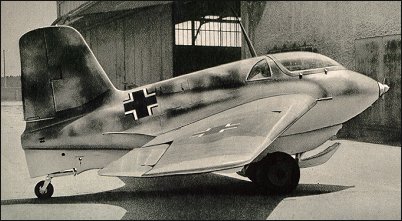 |
Messerschmitt Me-163 Komet1941 |  |
| ROCKET PLANE | Virtual Aircraft Museum / Germany / Messerschmitt |
 |
Few aircraft (if any) can have been as hair-raising to fly as the Messerschmitt Me 163 Komet. The first production examples were delivered to a new fighter wing, JG 400, in May 1944, but it was not until 16 August of that year that these revolutionary aircraft had their first (unsuccessful) brush with an Allied bomber stream. Their development can be said to have originated from work begun in 1933 by Dr Alexander Lippisch at the German Gliding Research Institute (DFS) at Darmstadt, being based on the Lippisch-designed DFS 194. Dr Lippisch and his staff were transferred to Messerschmitt's works at Augsburg in January 1939. In early 1940 the DFS 194 was equipped with a rocket motor at Peenemunde. After test flights by Heini Dittmar had confirmed speeds of up to 550km/h on the power of a single 2.94kN Walter motor, there was sufficient interest to initiate development. In 1941 the first Me 163 prototype was being tested in gliding flight and shortly after was fitted with a 7.35kN Walter RII-203 rocket motor. Speeds of up to 915km/h were achieved (limited by the volume of liquid propellants carried) and to gain some idea of the speed potential, this aircraft was towed to a high altitude before being released. Flown under power, a speed of over 1,000km/h was attained before the engine had to be throttled back because the aircraft was becoming uncontrollable. Operational Me 163B were powered by the 16.67kN Walter 109-509A-2 rocket motor. Each had mid-set monoplane wings of wooden construction and the fuselage was a semi-monocoque all-metal structure. Landing gear comprised a tailwheel, jettisonable main-wheel trolley and a central underfuselage skid which was extended for landing. Produced too late and in only small numbers (about 360 examples), they were in service in the defence of the Reich early in 1945 but had no significant impact upon the constant streams of Allied bombers attacking Germany. In theory their high speed and initial rate of climb of about 3,600m/minute should have made them a potent interceptor, despite the enormous hazards of training pilots and using these rocket-planes operationally. Had they enjoyed a longer period of development before introduction into service in the closing stages of the war, the story might have been very different. The slightly larger Me 163C development - with aerodynamic refinements, pressurised cockpit and blister-type canopy, and more powerful Walter 109-509C rocket motor - was built only in prototype and pre-production form. It did not enter service, although it was almost ready for delivery to Luftwaffe squadrons at the time of the German surrender. With this version, endurance was increased from eight-ten minutes to twelve minutes; this could be extended by periods of gliding. FACTS AND FIGURES © Armament was two powerful but slow-firing 30mm cannon. The pilot had little time to aim and hold his fire before he was past the target. One or two hits was usually enough to destroy a bomber, however. © The fuels in the Komet were highly corrosive and would dissolve organic material (such as the pilot). To avoid this, the pilots would wear special asbestos fibre suits. © The Komet took off on a two-wheeled trolley, which was quickly jettisoned. A retractable skid was used for landing, a bumpy process which sometimes caused unburned fuels to mix and ignite. © Combat tactics were to climb to altitude above the target and then turn off the motor to make diving attacks before restarting to climb again. When fuel was exhausted the Komet became a glider and very vulnerable to fighter attack. Messerschmitt Me-163 Komet on YOUTUBE

|  COMPANY PROFILE | ||||||||||||||||||||||||||||||||||||||||||||||||
 |

|

